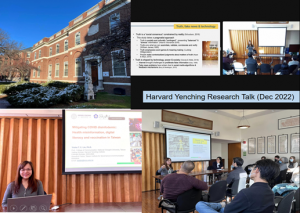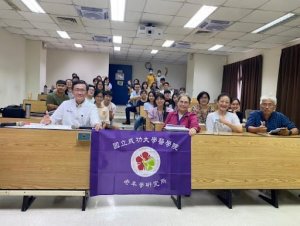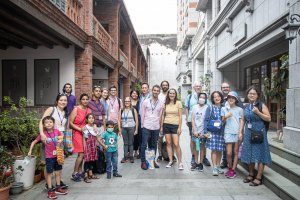Instead of writing an academic piece describing the eleven months I spent in Taiwan teaching and conducting research, let me instead express my thoughts about how staying in this country led me to perceive the strengths of its multifaceted society, some of the issues it faces, and its enormous potential. In doing so, I seek to avoid oversimplifying and embellishing the picture that now appears to me in increasing detail. Having lived for extensive periods in other parts of the world including Asia, Europe, and the United States, I realized that the longer one gets immersed in a particular environment, the harder it becomes to depict the complexity that befits every specific place and its people. Thus, when asked to summarize the main features of those particular places, unlike superficial impressions gleaned after a tourist visit, I usually begin with a disclaimer: “Would you prefer the short version in three sentences or the complicated long version?” This is my first attempt to articulate the long one.

- Taiwanese Society’s Recognition of Its Multiplicity
Most visitors and long-term residents agree that, overall, Taiwan stands out as Asia’s most progressive society in terms of recognizing its diversity, the complexity of its historical legacy, and also promoting democratic values that allow people to criticize their government when necessary. My favorite word to encapsulate the latter dimension is the current ironical usage of the word for “rebellious citizens” (diāomín 刁民), promoted by a restaurant chain that uses it in contrast with those who remain ignorant (yúmín 愚民) and let themselves be brainwashed. Although older sources used the same term with the dreadful connotation of “treacherous and cunning people,” its usage does not go far back in history, with the eighteenth-century Dream of the Red Chamber appearing to be one of the earliest instances. At any rate, one of the present-time marginal manifestations of this rebellion can be observed through street art/graffiti covering the walls of many streets in Taipei. I created a photo gallery to document this fascinating aspect of urban life: https://michelmohr.com/pictures/
The progressive bent of Taiwanese society, however, did not emerge from a vacuum. It largely resulted from a widespread awareness of what occurred under martial law between 1949 and 1987. Having witnessed firsthand the human rights violations following the repression known as White Terror, several generations still bear scars from this dark page of history and are acutely aware of how twisted political ideology can lead soldiers and police to torture their citizens. Now, in 2023, we are only 36 years away from the promulgation lifting the martial law on July 15, 1987 (jiěyán 解嚴). Yet it took another decade until a law to compensate the victims was issued in 1998. The relative closeness of these tragic events also provides a partial explanation for the lack of resentment toward what happened during the fifty years of the Japanese colonial period (1895–1945), unlike in Korea. In this regard, the double standards used by the Japanese Governor-General of Taiwan often resulted in treating aborigines as third-class citizens, resulting in less resentment from those of Chinese descent.
Mentioning this phase of recent history is only meant to underline how concerted efforts to acknowledge injustice (in this case the dark era between 1949 and 1987) can produce powerful incentives to strive toward a more inclusive society. Fast-forwarding to the twenty-first century, we can see how this awareness has resulted in adopting measures and legislation that aim at preventing past errors from being repeated. There’s no need to list these remarkable pieces of legislation, but one of the best indicators is provided by Taiwan’s proud standing as world #14 in the 2022 Human Freedom Index produced by the Cato Institute and the Fraser Institute. It comes before Japan (#16) and stands out as the first country in Asia.
Rather than judging by quantitative rankings, we can observe how Taiwan’s strengths in this area contribute to making it a beacon of diversity and inclusion. Examining this from the perspectives of Religious Studies and Philosophy suggests a huge potential for launching new ideas, debating controversial topics, and engaging in meaningful conversations that translate into action. Regardless of the boundaries that may separate various disciplines and approaches, vast segments of the population remain deeply interested in imagining an even more progressive society. A recent occasion to confirm this assumption was provided through an exhibition called WeWe Futures (Tóu nǐ de wèilái 投你的未來) dedicated to designing models for the future. It constituted one section of the July 2023 exhibitions at the Songshan Cultural and Creative Park in Taipei. The assigned theme for this competition was “Diversity and Inclusion” (Duōyuán gòngróng 多元共融), suggesting that recognizing diversity is only the first intellectual step in a process whose outcome may remain hollow until it moves to the next level of inclusion in all its complexity. Looking at how an excessive emphasis on diversity can lead to fragmentation and the emergence of split identities (a frequent disease in postmodern societies), pointing out shared roots and values despite diverse backgrounds constitutes one of the key aspects to maintaining a modus of social cohesion. I will return to this in the last section of this essay.
- Some of the Current Issues
The above depiction of current Taiwanese society as a success story should not be misinterpreted as a complacent account neglecting the in-depth issues that it also needs to face. I will mostly leave aside geopolitical considerations. When talking about integration, for instance, some minorities are less integrated than others. People of aboriginal descent still suffer from occasional discrimination while the growing proportion of elderly people has more recently led to recruiting an increasing number of foreign workers, often coming from Indonesia and neighboring countries. These workers make amazing efforts to learn the language (sometimes both Mandarin and Taiwanese), yet those wearing a scarf because of their Muslim faith become easily recognizable, thereby highlighting a different background and unwillingly bringing attention to the issue of assimilation.
Every society consciously or unconsciously adopts distinctive criteria to identify otherness, which does not necessarily translate into treating people differently yet implies setting up boundaries. In Taiwan, further subtle distinctions are also often established between those who came from the mainland later than the first wave of immigration (wàishěngrén 外省人), those of Hakka descent, or new immigrants. Given that the multi-ethnic composition of the country originally derived from events following the fall of the Ming dynasty in the seventeenth century, one can legitimately ask “Who can claim to be a true native?” Several years ago, Neil Abercrombie—who was then Governor of the State of Hawaii—gave a talk at the university where he mentioned how the Hawaiian Islands were populated first by navigators coming from Polynesia, followed by several waves of immigration from other parts of the world. He observed that, although settlers have various degrees of seniority, ultimately, everyone dwelling in the archipelago is an islander. It implies that the islands own their inhabitants, not the opposite. The same could be said about Taiwan, populated by multiple strata of individuals whose origins can be traced back to various locations. This constitutes an asset, and its recognition translates into tremendous flexibility and hospitality.
Other parameters include economic disparities, most visible in rural areas and by observing the growing homeless population. The capitalist economic model favors a minority of privileged individuals, and Taiwan is no exception. Rising living costs and the shortage of well-paid jobs for young graduates have led some residents to be tempted by the larger markets abroad. In any case, although the Taiwanese National Health Insurance should inspire other countries, it cannot possibly address all the issues of those in need. Similarly, despite gigantic leaps forward in areas associated with gender and sexual equality, the recent surge of allegations akin to the “Me Too” movement shows that discriminatory practices toward women remain deeply entrenched. Another surprising dimension is the relatively scarce number of hybrid and electric vehicles on an island that could be at the forefront of ecological awareness. Although all of the aforementioned issues are not unique to Taiwan, let me also mention the potential contribution of Religious Studies and Philosophy to one of them.
The research project that I conducted in Taiwan provides one avenue to investigate the country’s roots of discrimination. Highlighting this dimension will also explain why Taiwan is especially well positioned to stand at the vanguard in this area, and how it could contribute to serve as a model in tackling this sensitive question.
- Taiwan’s Contribution to Nurturing New Universalism
It begins by asking a seemingly benign question: Where does discrimination come from? When looking beyond the socio-economic factors that feed into this phenomenon, we can identify its roots as stemming from the way our mind works. Every second, we differentiate between age groups, professions, gender, and physical appearances, in a constant flow of instantaneous labeling of other individuals. Sometimes, deprecating judgments are even directed at oneself, by comparing one’s status to that of others, a frenzy that is fueled by social media.
Asian religious traditions provide crucial hints about how this happens, the psychological mechanisms implied, and avenues to overcome false identifications. Without delving into the subtle ways through which the ego constructs its own identity and that of others, we can begin by suggesting a simple antidote to this pervasive tendency: The idea of common ground, which is what unites us despite individual differences. Regardless of belief systems or the lack thereof, some markers identify the existential condition independently from words; they constitute our empirical reality and remain constant across time and space. The paramount example is death and its unavoidable universal character. Birth constitutes its immediate corollary and shares the same attribute while aging and disease likewise constitute distinctive marks of the existential condition.
So far, it should sound familiar. Going one step further, these markers can be called “universals” and their invariable nature is described by speaking of “universality.” This is where my research conducted in Taiwan ventures to advance a new hypothesis. If we decontextualize the word “universality” and strip it from connotations linked to Western history and colonialism, then we can identify in the Sinosphere a strikingly early formulation of the universal human nature and its potential. Since at least the 5th century CE the pivotal term rúláizàng 如來藏 indicating the Buddha-nature served to translate the Sanskrit tathāgatagarbha, with revolutionary implications that quickly spread throughout East Asia. Taking this into account contributes to dispelling the misconception that “universality” is a Eurocentric concept. Furthermore, the subversive claim that everyone is equally endowed with a perfect nature constitutes East Asia’s earliest articulation of universalism. Why is this relevant to us here and now in the twenty-first century and why should it concern Taiwan?
Having these conversations and reopening debates about universalism can only occur in an unprejudiced democratic society. Additionally, the Taiwanese academic community is one of the most open-minded and intellectually stimulating environments one can dream of. Being able to collaborate with brilliant colleagues in the Department of Philosophy at National Taiwan University provided me with a perfect setting to test the validity of such hypotheses about universality in the uniquely diverse context of Taiwanese society. In addition to bridging the gap between Religious Studies and Philosophy, we may now confidently reopen debates forestalled by the hermeneutics of suspicion (Nietzsche, Marx, Freud, and postmodern philosophy). The time has come to demonstrate how the Sinosphere’s early form of universalism can inspire dialogue across the region and beyond. Collaboration focused on this idea entails long-term benefits that can contribute even to nurturing discussions between policymakers in both the United States and Taiwan, because the issues at stake touch upon the core definition of shared values and ideals.
Managing Editor: Sophia Pivnik







